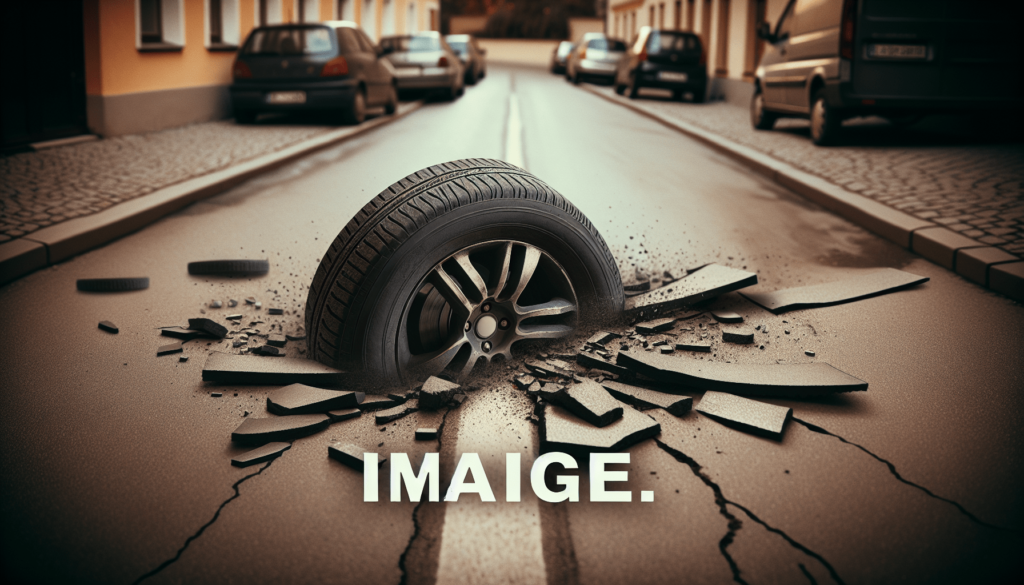Have you recently hit a curb while driving? It happens to the best of us, but it’s important to be aware of the potential consequences, such as misaligned wheels. Misaligned wheels can lead to various issues with your vehicle’s steering, suspension, and overall performance. In this article, we’ll explore the telltale signs of misaligned wheels after hitting a curb, helping you determine when it may be necessary to seek professional assistance. So, if you’ve had a little mishap and want to ensure your wheels are in perfect alignment, keep reading!
1. Uneven Tire Wear
When your wheels are misaligned, one of the most common signs you may notice is uneven tire wear. This means that the tires on your vehicle are not wearing evenly across the tread surface. There are a few different types of uneven tire wear that you should be aware of:
1.1 Inner or outer edge wear
One type of uneven tire wear that you may come across is wear on either the inner or outer edge of the tire. This usually indicates that there is too much or too little toe-in or toe-out alignment. Toe-in refers to the front edges of the tires pointing slightly inward, while toe-out refers to the front edges pointing slightly outward. When the alignment is off, it can cause the tires to wear unevenly on the inner or outer edges, which can be easily observed by inspecting the tread.
1.2 Feathering
Another type of uneven tire wear is feathering. Feathering occurs when the tread on one side of the tire is smooth, while the tread on the other side has a sawtooth appearance. This can be caused by improper toe or camber alignment. Camber is the angle of the wheels in relation to the road surface, and when it is misaligned, it can lead to feathering.
1.3 Cupping
Cupping is yet another form of uneven tire wear that is characterized by small, scalloped divots along the tread surface. This type of wear is usually caused by issues with the suspension components or improper tire rotation. When the wheels are misaligned, it can affect the way the tires make contact with the road, resulting in cupping.
2. Vehicle Pulls to One Side
If you find that your vehicle has a tendency to pull to one side while driving, it is highly likely that you have misaligned wheels. When the tires are not properly aligned, it can create an imbalance in the forces acting on the vehicle, causing it to veer to one side. This can not only be frustrating but also potentially dangerous, as it requires constant steering correction to keep the vehicle on a straight path.

3. Steering Wheel Vibrates
Another telltale sign of misaligned wheels is a vibrating steering wheel. When the alignment is off, it can result in an uneven distribution of weight on the tires, leading to vibrations that are felt through the steering wheel. These vibrations may become more pronounced as the vehicle’s speed increases. If you feel a constant shaking or vibration in your steering wheel, it’s a clear indication that your wheels need to be realigned.
4. Crooked Steering Wheel
Have you ever noticed that your steering wheel is not centered and appears to be turned slightly to one side, even when driving straight? This is another indication of misaligned wheels. When the wheels are not properly aligned, it can cause the steering wheel to be off-center. It may seem like a minor issue, but it can have a significant impact on your driving experience, as you may find yourself constantly adjusting the steering wheel to drive in a straight line.

5. Squealing Tires
Misaligned wheels can also contribute to the issue of squealing tires. When your tires are not aligned correctly, it can cause uneven pressure and friction on the tires, leading to squealing when turning or driving. This is often a result of excessive toe or camber misalignment. Squealing tires not only create an unpleasant noise but can also indicate that there is premature wear on the tires, reducing their lifespan.
6. Increased Fuel Consumption
If you notice a sudden increase in your vehicle’s fuel consumption, it may be due to misaligned wheels. When your wheels are not aligned correctly, it can result in increased rolling resistance, meaning that the tires require more effort to rotate. This increased resistance can cause your engine to work harder, resulting in higher fuel consumption. If you find yourself making more frequent trips to the gas station without any changes to your driving habits, it’s worth considering wheel alignment as a possible solution.

7. Difficulty in Steering
When your wheels are misaligned, you may experience difficulty in steering your vehicle. Misalignment can make the steering feel heavy or stiff, requiring more effort to turn the wheel. This is because misaligned wheels can cause the tires to drag or scrub against the road surface, making it harder to maneuver the vehicle with ease. If you find yourself wrestling with the steering wheel to change directions or feeling like your vehicle is not responding as it should, getting a wheel alignment should be a priority.
8. Steering Wheel Doesn’t Return to Center
An additional sign of misaligned wheels is when your steering wheel doesn’t return to the center position after making a turn. Normally, after completing a turn, the steering wheel should naturally return to a neutral position. However, when the alignment is off, the steering wheel may remain turned slightly to one side. This can be not only inconvenient but may also indicate a misalignment issue that needs to be addressed.

9. Abnormal Noises
Misaligned wheels can also generate various abnormal noises. One common noise associated with misalignment is a clunking or rattling sound coming from the suspension components. This can occur when the misaligned wheels are causing excessive strain on the suspension, leading to loose or worn-out parts. Additionally, misalignment can cause unusual tire noise, such as humming or whining, due to the uneven wear patterns. If you hear any strange noises while driving, it’s essential to have your wheels checked for misalignment.
10. Tires Losing Pressure
Lastly, if you find that your tires are losing air pressure more frequently than usual, it could be a sign of misaligned wheels. When the wheels are not aligned correctly, it can lead to uneven tire wear, as mentioned earlier. This uneven wear can create vulnerable spots on the tires, making them more susceptible to punctures or leaks. If you regularly notice that your tires are losing pressure, even after inflating them properly, it’s worth considering a wheel alignment to prevent further tire damage and ensure optimal tire performance.
In conclusion, there are several noticeable signs that indicate misaligned wheels after hitting a curb. These signs include uneven tire wear, vehicle pulling to one side, vibrating steering wheel, crooked steering wheel, squealing tires, increased fuel consumption, difficulty in steering, steering wheel not returning to center, abnormal noises, and tires losing pressure. If you experience any of these signs, it is important to address the issue promptly and get a professional wheel alignment to ensure a safe and smooth driving experience. Remember, a properly aligned vehicle not only improves the lifespan of your tires but also enhances overall vehicle performance and safety.


